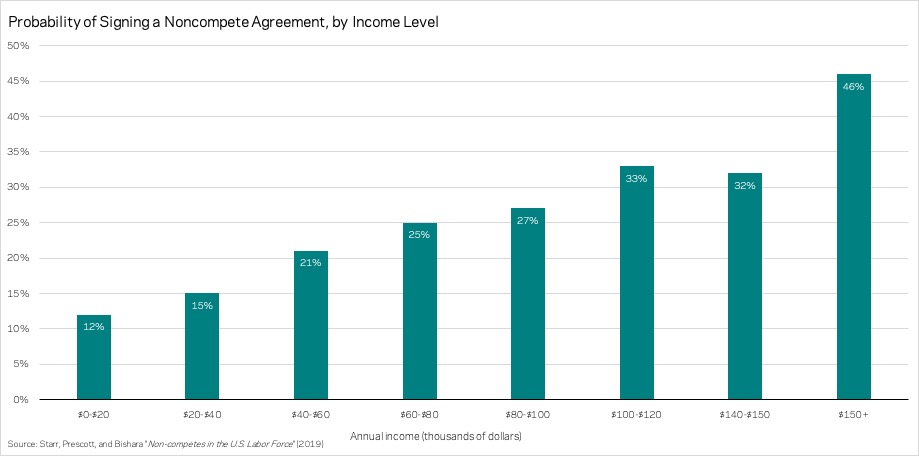By Jimmy O’Donnell
Introduction
Today, Senators Chris Murphy (D-CT), Todd Young (R-IN), Kevin Cramer (R-ND), and Tim Kaine (D-VA) and Representatives Scott Peters (D-CA), Mike Gallagher (R-WI), Anna Eshoo (D-CA), and Peter Meijer (R-MI-03) reintroduced the Workforce Mobility Act in Congress. This bipartisan bill, which was originally introduced in the Senate in 2019 and the House in 2020, seeks to prohibit the use of non-compete agreements in most circumstances in the United States. The Economic Innovation Group (EIG) has worked closely with the bill’s co-sponsors on this effort and strongly supports the bill’s reintroduction.
Non-compete agreements—often referred to as just “non-competes”—are a practice whereby employers require their employees, as a condition of their employment, to sign a contract stating that they will not work at another firm that competes, directly or indirectly, with their current employer. The theory behind this sort of contract may at first seem defensible: if an employer hires a worker and then invests time and money in training that worker, the employer should be able to protect against the threat of the worker immediately leveraging their newly gained firm-specific or industry-specific skills to get a better job at a competing firm.
However, in practice, these agreements have been applied broadly to millions of workers, many of whom pose no competitive threat to their employer. Instead, non-competes are used to further protect the economic position of firms by exploiting the limited bargaining power of their workers. For instance, it was only after a New York State investigation that the sandwich chain Jimmy John’s stopped requiring its store workers to sign non-competes. Prior to that investigation, Jimmy John’s store workers had to sign agreements that prevented them from taking another job with a competitor (i.e., any fast food restaurant) for two years and from taking a job at a store within two miles of a Jimmy John’s that made more than 10 percent of its revenue from sandwiches (i.e., most food-related stores in New York City).
In addition to the undue burdens they place on workers, non-compete agreements also stifle entrepreneurship and innovation, restricting the dynamic potential of the U.S. economy. Since many entrepreneurs are often inspired to start businesses in the sectors they work in—leveraging existing skills, industry know-how, and an understanding of spaces for new opportunity—non-compete agreements significantly deter workers’ ability to venture out on their own. While the need to protect trade secrets or company-specific information is valid, non-compete agreements are a poor way to achieve this goal, especially when employers have alternative and more narrowly-scoped tools available to protect legitimate interests, such as non-disclosure agreements. Non-competes, by contrast, are a blunt instrument often written so broadly that they go far beyond the goal of protecting a company’s proprietary information.
Non-compete agreements, on top of being generally problematic for worker freedom and economic growth, have posed particular challenges during the COVID-19 pandemic. With millions of workers laid off as a result of the pandemic-induced recession, many have found it difficult to take advantage of new job opportunities or start their own firms because many non-compete agreements remain valid even in cases of layoffs. There have been several court cases involving these sorts of disputes between workers and their former employers. Non-compete agreements not only limit the long-term capacity of the U.S. economy, but may also be a significant obstacle to the economy’s ability to rebound from the COVID-19 recession.
Non-competes and Their Economic Impact
Today, roughly 20 percent of all workers (i.e., approximately 30 million Americans) are covered by a non-compete agreement, and an estimated 40 percent of workers have been bound by a non-compete agreement at some point in their career. However, this coverage is by no means uniform across industries or occupations. By sector, the prevalence of non-competes ranges from nine percent in the agricultural industry to upwards of 30 percent in the professional, scientific, and technical industry. By occupation, 11 percent of workers in groundskeeping and maintenance jobs are bound by non-compete agreements whereas 26 percent healthcare support workers have signed a non-compete. Lastly, workers all across the income distribution face the prospect of signing a non-compete agreement (see figure below). Although higher-income workers are the most likely to be bound by one (46 percent of workers earning over $150,000), a significant share of middle- and lower-income workers also face the challenges of signing a non-compete agreement: 21 percent of workers making between $40,000 and $60,000 as well as 12 percent of workers earning less than $20,000.
Clearly, non-compete agreements affect large swaths of the U.S. workforce. So the question stands: what is the actual economic impact of non-competes? In short, non-competes hurt workers and the broader economy, primarily through reduced wages and less entrepreneurship, respectively. For workers, non-competes often restrict their ability to switch jobs in their area of expertise. An increasingly robust set of academic literature documents non-competes’ negative effects on worker wages and mobility. As we have highlighted in EIG’s earlier work:
- Non-compete enforcement hurts worker wages: Although many studies on non-competes are case studies or state-specific, the abundance of the research finds negative effects on wages.
- These negative wage effects are worse for historically marginalized workers: New research has found that stricter non-compete enforceability lowers earnings for female and nonwhite workers by twice as much as for white male workers. Other studies have shown that workers with less education experience larger negative wage impacts from non-competes.
- Non-competes deter workers from finding better opportunities: Workers bound by a non-compete stay in their jobs 11 percent longer. Since job mobility is key for boosting earnings, these longer tenures reinforce the negative earnings effects of non-competes.
More broadly, non-competes reduce entrepreneurship because they discourage workers from starting and growing new firms. This is true for two reasons: first, many would-be entrepreneurs are bound by a non-compete and are forbidden from creating a new rival firm in their industry. Since many entrepreneurs decide to form new businesses in order to leverage their specific skill set or capitalize on an opportunity they see in their sector, non-competes prevent them from being able to use those advantages, and thus limit the likelihood that they will form new firms. Second, even if a worker can get a business started, they may face significant challenges in finding employees if much of the talent pool is similarly bound by non-competes. Accordingly, the empirical research documents significant negative impacts of non-competes on U.S. economic dynamism:
- Non-competes reduce entrepreneurship: Recent research has found that stricter enforceability of non-competes reduces firm entry and spinout rates significantly in knowledge-intensive sectors. More generally, firms that start under strict non-competes regimes remain smaller and are less likely to survive.
- Like wages, these negative effects on new business growth are worse for underrepresented entrepreneurs: The threat of non-compete enforcement appears to particularly dampen entrepreneurship among women.
- Non-competes likely slow the pace of innovation: Non-competes obstruct the flow of knowledge by restricting the churn of workers among firms. They make venture capital less effective in spurring new patents and job growth.
Policy Reforms to Address Non-competes
Taken together, non-competes represent a drag on economic efficiency and output for the U.S. economy. The prevailing policy approach thus far has been to address non-competes at the state-level. (For an overview of recent state-level policies on non-competes, see Appendix A and B here.) However, this patchwork approach results in states differing widely in their treatment of non-competes: some allow for non-competes and enforce them in full, others allow them but enforce them to varying extents, and still others do not enforce them at all.
Since the body of empirical evidence demonstrates that the negative impacts of non-compete agreements outweigh any meager and narrow benefits they may offer to employers, the optimal policy strategy is the outright ban of non-competes, with few exceptions, which would unleash the full labor potential and entrepreneurial capacity of the U.S. economy. Fortunately, the recently reintroduced Workforce Mobility Act does just that, banning non-competes in all but the most narrow of circumstances.
Specifically, it would forbid employers from having their workers sign non-competes, except in the rare “necessary instances of a dissolution of a partnership or the sale of a business.” In other words, the overwhelming majority of workers currently bound by non-competes would be freed from those limitations. A second important plank of the bill is that employers would now be required to make their workers aware of this ban on non-competes by putting up posters about the law in the workplace (as is done with many other workplace laws such as the Fair Labor Standards Act). This second point is significant because the academic literature has shown that signed non-competes still can scare and deter workers, even in states where the agreements are not enforceable. Lastly, the Workforce Mobility Act calls for appropriate and effective enforcement of the ban by federal regulators, namely the Department of Labor and the Federal Trade Commission. By empowering these federal agencies, the bill balances the power scales between workers and employers. In all, the Workforce Mobility Act’s near-universal federal ban on non-compete agreements marks a significant step in empowering workers and spurring economic dynamism.
Conclusion
Fundamentally, non-compete agreements are a barrier to the American ideals of economic liberty and open, competitive marketplaces. By stripping workers of their autonomy to choose which employment opportunities to pursue and when, non-competes restrict individuals from fully and freely controlling their own labor. Furthermore, non-competes rob workers of one of their most valuable assets in terms of entrepreneurial activity: the accumulation of their industry-specific skills and know-how.
Banning the use of non-compete agreements would go a long way in raising wages for workers and empowering more would-be entrepreneurs to start new companies. Importantly though, non-competes are just one piece of a larger anti-worker suite of contracts imposed on workers. Other such anti-worker agreements (also known as “contracts of dispossession”) include occupational licensing, “no-poach” agreements, and others. If Congress and state governments want to support workers and unleash the full dynamic potential of the economy, then they should aggressively push for major reform in these areas as well. In the meantime, there is significant momentum behind the issue of non-compete reform, and legislation such as the Workforce Mobility Act would be an important step toward supporting workers and spurring entrepreneurship.







